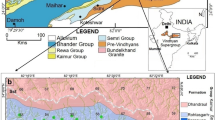Abstract
Sequential leaching experiments were made on Recent glauconies and clay fractions of the associated mud from off-shore Africa near the estuary of the Congo River. Analyses of major/rare earth elements (REE) and Nd isotopic compositions on the resulting leachate and residue pairs allow identification of at least three important and isotopically distinct components which contributed to the glauconitization process: (1) a detrital component with relatively high 87Sr/86Sr and relatively low 143Nd/144Nd isotopic ratios; (2) a phosphate phase rich in REE and Sr with sea water Sr and Nd isotopic characteristics; (3) a component rich in organic matter and Ca with a sea water Sr isotopic signature, a relatively low Nd isotopic composition and elevated Sm/Nd ratios. This latter component probably represents the suspended organic and carbonate-rich river load. The detrital and the river components were mixed up in the muddy off-shore sediment, ingested by worms, and integrated into faecal pellets. The resulting material has Sr and Nd isotopic signatures intermediate between those of the detrital and river components, and represents the precursor of the glaucony minerals. During the subsequent dissolution-crystallization process, the glauconitic pellets remain isotopically closed to any external supply, but expulsion of Sr and Nd with increasing degree of maturation is observed without any effect on the Sr and Nd isotopic compositions. At a higher maturation stage (K2O>4.5%), the Sr and Nd isotopic compositions tend to decrease and increase, respectively, approximating the isotopic composition values of the phosphate-rich phase. Because the Sr and Nd concentrations decrease, the evolution of the glauconies toward lower Sr and higher Nd isotopic compositions can only be explained by expulsion of Sr and Nd of the detrital component with high Sr and low Nd isotopic signatures. Dissolution of the chemically unstable, wormdigested clay material from mud may be responsible for the liberation of these elements. Consequently, the phosphate-rich phase with sea water Sr and Nd isotopic signatures becomes increasingly important for the isotopic characteristics of the maturing glauconite grains, and sea water isotopic signatures can be reached during the stage of mature glauconite (K2O>6.5%), without chemical exchange with the depositional environment.
Similar content being viewed by others
References
Bonnot-Courtois C (1981) Géochimie des terres rares des principaux milieux de formation et de sédimentation des argiles. D es-Sci thesis, Univ Paris Sud
Bros R, Stille P, Gauthier-Lafaye F., Weber F, Clauer N (1992) Sm-Nd isotopic dating of Proterozoic clay material: an example from the Francevillian sedimentary series (Gabon). Earth Planet Sci Lett 113:207–218
Burst JF (1958a) Mineral heterogeneity in glauconite pellets. Am Mineral 43:481–497
Burst JF (1958b) “Glauconite” pellets: their mineral nature and applications to stratigraphic interpretations. Am Assoc Pet Geol Bull 42:310–337
Clauer N (1976) Géochimie isotopique du strontium des milieux sédimentaires. Application à la géochronologie de la converture du craton ouest-africain. Sci Géol chém, Strasbourg, 45, 256 pp
Clauer N, Keppens E, Stille P (1992a) Sr isotope constraints on the process of glauconitization. Geology 20:133–136
Clauer N, Stille P, Keppens E, O'Neil JR (1992b) Le mécanisme de la glauconitisation: apports de la géochimie isotopique du strontium, du néodyme et de l'oxygène de glauconies récentes. C R Acad Sci Paris 315/II:321–327
Fischer H, Steiger RH (1988) The influence of sediment lithification on K-Ar ages and chemical zoning of glauconites. Schweiz Mineral Petrogr Mitt 68:203–214
Hower J (1961) Some factors concerning the nature and the origin of glauconite. Am Mineral 46:313–334
Keppens E, O'Neil JR (1984) Oxygen isotope variations in glauconies. Terra Cognita Spec iss:42
Odin GS (1975) De glauconarium constitutione, origine, aetateque. D es-Sci thesis, Univ Paris
Odin GS (ed) (1982) Numerical dating in stratigraphy. Wiley, Chichester
Odin GS (ed) (1988) Green marine clays. (Developments in Sedimentologie, 45). Elsevier Science Publ, Amsterdam
Odin GS, Dodson MH (1982) Zero isotopic age of glauconies. In: Odin GS (ed) Numerical dating in stratigraphy. Wiley, Chichester, pp 277–305
Odin GS, Fullagar PD (1988) Geological significance of the glaucony facies. In: Odin GS (ed) Green marine clays. (Developments in Sedimentologie, 45) Elsevier Science Publ, Amsterdam
Odin GS, Matter A (1981) De glauconarium origine. Sedimentology 28:611–641
Odin GS, Dodson MH, Hunziker JC, Kreuzer H (1979) Radiogenic argon in glauconies during their genesis. Bull Liaison Inf IGCP Project 133/6:7–8
Piepgras DJ, Wasserburg GJ, Dasch EJ (1979) The isotopic composition of Nd in different ocean masses. Earth Planet Sci Lett 45:223–236
Schaltegger U, Stille P, Rais N, Piqué A, Clauer N (1994) Sr and Nd isotopic and rare earth elementary fractionations in clay fractions of argillaceous sediments: decoupling of the isotopic systems during low-grade metamorphism. Geochim Cosmochim Acta 58:1471–1481
Stille P, Fischer H (1990) Secular variation in the isotopic composition of Nd in Tethys seawater. Geochim Cosmochim Acta 54:3139–3145
Stille P, Gauthier-Lafaye F, Bros R (1993) The neodymium isotope system as a tool for petroleum exploration. Geochim Cosmochim Acta 57:4521–4525
Author information
Authors and Affiliations
Rights and permissions
About this article
Cite this article
Stille, P., Clauer, N. The process of glauconitization: chemical and isotopic evidence. Contr. Mineral. and Petrol. 117, 253–262 (1994). https://doi.org/10.1007/BF00310867
Received:
Accepted:
Issue Date:
DOI: https://doi.org/10.1007/BF00310867




